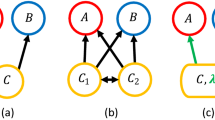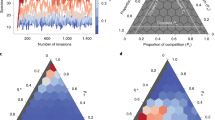Abstract
A model is proposed of an ecological community where some (or all) of the subpopulations exhibit mutual interference. Mutual interference introduces sublinearities which makes the persistence analysis of the community more complex since the model is no longer a dynamical system. A transformation is introduced which yields a dynamical system, thereby making a persistence analysis more tractable. The results are applied to determining top-predator persistence of a simple food chain and to the question of invasibility of a stable community by a new subpopulation.
Similar content being viewed by others
Literature
Austin, M. P. and B. G. Cook. 1974. “Ecosystem Stability: a Result from an Abstract Simulation.”J. theor. Biol. 45, 435–458.
Beddington, J. R. 1975. “Mutual Interference between Parasites on Predators and its Effects on Searching Efficiency.”J. Anim. Ecol. 44, 331–340.
Coppel, W. A. 1965.Stability and Asymptotic Behavior of Differential Equations. Boston: D. C. Heath.
DeAngelis, D. L., R. A. Goldstein and R. V. O'Neill. 1975. “A Model for Trophic Interactions.”Ecology 56, 881–892.
Freedman, H. I. 1979. “Stability Analysis of a Predator-Prey System with Mutual Interference and Density-dependent Death Rates.”Bull. math. Biol. 41, 67–78.
— and V. S. H. Rao. 1983. “The Trade-off Between Mutual Interference and Time Lags in Predator-Prey Systems.”Bull. math. Biol. 45, 991–1004.
— and P. E. Waltman. 1977. “Mathematical Analysis of Some Three-species Foodchain Models.”Math. Biosci. 33, 257–276.
— and —. 1984. “Persistence in Models of Three Interacting Predator-Prey Populations.”Math. Biosci. 68, 213–231.
Futuyma, D. J. 1973. “Community Structure and Stability in Constant Environments.”Am. Nat. 107, 443–446.
Goh, B. S. 1975. “Stability, Vulnerability and Persistence of Complex Ecosystems.”Ecolog. Model. 1, 105–116.
—. 1977. “Global Stability in Many Species Systems.”Am. Nat. 111, 135–143.
Hartman, P. 1973.Ordinary Differential Equations. Baltimore: Hartman.
Hassell, M. P. 1971. “Mutual Interference between Searching Insect Parasites.”J. Anim. Ecol. 40, 473–486.
— and R. M. May. 1973. “Stability in Insect Host-Parasite Models.”J. Anim. Ecol. 42, 693–726.
Hastings, H. M. 1979. “Stability Considerations in Community Organization.”J. theor. Biol. 78, 121–127.
Levin, S. A. 1970. “Community Equilibria and Stability, an Extension of the Competitive Exclusion Principle.”Am. Nat. 104, 413–423.
Lewontin, R. C. 1969. “The Meaning of Stability.” InDiversity and Stability in Ecological Systems, pp. 13–42, Brookhaven Symposia in Biology No. 22.
Lin, J. and P. B. Kahn. 1977. “Quantative Behavior of Predator-Prey Communities.”J. theor. Biol. 65, 101–132.
May, R. M. 1973.Stability and Complexity in Model Ecosystems. Princeton: Princeton University Press.
Nemytskii, V. V. and V. V. Stepanov. 1960.Qualitative Theory of Differential Equations. Princeton: Princeton University Press.
Preston, F. W. 1969. “Diversity and Stability in the Biological World.” InDiversity and Stability in Ecological Systems, pp. 1–12. Brookhaven Symposia in Biology No. 22.
Robinson, J. V. and G. S. Ladde. 1982. “Feasibility Constraints on the Elastic Expansion of Ecological Models.”J. theor. Biol. 97, 277–287.
Rogers, D. J. and M. P. Hassell. 1974. “General Models for Insect Parasite and Predator Searching Behaviour: Interference.”J. Anim. Ecol. 43, 239–253.
— and S. Hubbard. 1974. “How the Behaviour of Parasites and Predators Promotes Population Stability.” InEcological Stability (Eds M. B. Usher and M. H. Williamson), pp. 99–119. London: Chapman & Hall.
Rosen, G. 1977. “On the Persistence of Ecological Systems.”J. theor. Biol. 65, 795–799.
Siljak, D. D. 1975. “When is a Complex Ecosystem Stable?.”Math. Biosci. 25, 25–50.
Takeuchi, Y. and N. Adachi. 1980. “The Existence of Globally Stable Equilibria of Ecosystems of the Generalized Volterra type.”J. math. Biol. 10, 401–415.
Takeuchi, Y., N. Adachi, and H. Tokumaru. 1978. “Global Stability of Ecosystems of the Generalized Volterra Type.”Math. Biosci. 42, 119–136.
Thomas, W. R. and M. J. Pomerantz. 1981. “Peasibility and Stability in Community Dynamics.”Am. Nat. 117, 381–385.
Wörz-Busekros, A. 1978. “Global Stability in Ecological Systems with Continuous Time Delay.”SIAM J. appl. Math. 35, 123–134.
Yodzis, P. 1981. “The Stability of Real Ecosystems.”Nature 289, 674–676.
Author information
Authors and Affiliations
Additional information
Research partially supported by the Natural Sciences and Engineering Research Council of Canada.
Rights and permissions
About this article
Cite this article
Erbe, L.H., Freedman, H.I. Modeling persistence and mutual interference among subpopulations of ecological communities. Bltn Mathcal Biology 47, 295–304 (1985). https://doi.org/10.1007/BF02460038
Received:
Issue Date:
DOI: https://doi.org/10.1007/BF02460038




